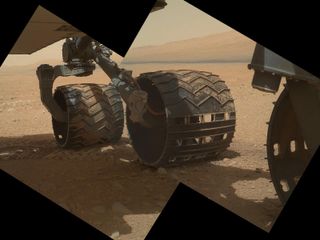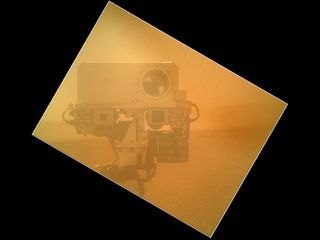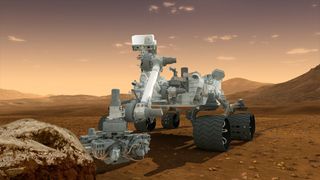Mars Rover Curiosity Snaps Amazing Hi-Res Self Portraits (Photos)

NASA's Mars rover Curiosity is doing a bit of mechanical navel-gazing on the Red Planet, snapping ultra-clear pictures of itself while testing a powerful camera at the tip of its robotic arm.
The stunning new Mars photos by Curiosity show detailed views of its wheels and underbelly, a self-portrait of the robot's head-like camera mast and even a snapshot of an odd bit of Americana — a 1909 Lincoln penny used for calibration — that hitched a ride to the Red Planet with the rover.

The Curiosity rover took the photos over the weekend using its Mars Hand Lens Imager, or MAHLI, which is a focusable color camera attached to an instrument turret at the end of Curiosity's 7-foot (2.1–meter) robotic arm. MAHLI snapped its first photo of the Martian surface without a protective dust cover on Saturday (Sept. 8), and then began taking clear pictures of Curiosity itself a day later.
In one photo, the camera takes a clear look at Curiosity's three left wheels in a view that is framed by the rover's belly above. Curiosity's ultimate destination, the 3-mile-high (5-kilometer) Mount Sharp that rises from the center of the rover's Gale Crater landing site, can be seen in the distance. [11 Amazing Things Curiosity Can Do]

Another snapshot, taken on Friday (Sept. 7), captures a dusty view of Curiosity's camera mast. The photo appears hazy not because of a dust storm, but because the dust cover on MAHLI was closed at the time.
The MAHLI device is designed to serve as a microscope-like magnifying camera for close-up studies of rock targets, and it has a resolution of about one 1,000th of an inch (14 microns) when held within an inch of its target. By changing the MAHLI camera's focus and its position (by moving Curiosity's arm), rover mission scientists expect to be able to take time-lapse views of Mars and examine rover hardware while on the Martian surface.
"The main purpose of Curiosity's MAHLI camera is to acquire close-up, high-resolution views of rocks and soil at the rover's Gale Crater field site," NASA officials wrote in one image description. "The camera is capable of focusing on any target at distances of about 0.8 inch (2.1 centimeters) to infinity, providing versatility for other uses, such as views of the rover itself from different angles."
Get the Space.com Newsletter
Breaking space news, the latest updates on rocket launches, skywatching events and more!
Veteran space camera builder Malin Space Science Systems of San Diego, Calif., built the MAHLI camera on Curiosity for NASA. The camera snaps photos using a red-blue-green filter, much like commercial digital cameras on Earth, and stores them in an 8-gigabyte flash memory for transmission to Earth. The camera relies on a charged-coupled device (CCD) image detector that uses a 1,600 by 1,200 array of active pixels, according to a NASA description.

The MAHLI camera is one of 17 imagers on the Mars rover Curiosity designed to study the Red Planet in unprecedented detail, as well as provide vital views for navigation and hazard avoidance. The MAHLI camera and other instruments at the end of Curiosity's robotic arm are currently being put through a series of tests to make sure they are ready to begin up-close studies of Mars, mission managers have said.
The $2.5 billion Curiosity rover landed on Mars on Aug. 5 and is expected to spend the next two years exploring Gale Crater to determine if the region could have once supported microbial life.
You can follow SPACE.com Managing Editor Tariq Malik on Twitter @tariqjmalik and SPACE.com on Twitter @Spacedotcom. We're also on Facebook & Google+.

Join our Space Forums to keep talking space on the latest missions, night sky and more! And if you have a news tip, correction or comment, let us know at: community@space.com.

Tariq is the Editor-in-Chief of Space.com and joined the team in 2001, first as an intern and staff writer, and later as an editor. He covers human spaceflight, exploration and space science, as well as skywatching and entertainment. He became Space.com's Managing Editor in 2009 and Editor-in-Chief in 2019. Before joining Space.com, Tariq was a staff reporter for The Los Angeles Times covering education and city beats in La Habra, Fullerton and Huntington Beach. In October 2022, Tariq received the Harry Kolcum Award for excellence in space reporting from the National Space Club Florida Committee. He is also an Eagle Scout (yes, he has the Space Exploration merit badge) and went to Space Camp four times as a kid and a fifth time as an adult. He has journalism degrees from the University of Southern California and New York University. You can find Tariq at Space.com and as the co-host to the This Week In Space podcast with space historian Rod Pyle on the TWiT network. To see his latest project, you can follow Tariq on Twitter @tariqjmalik.
